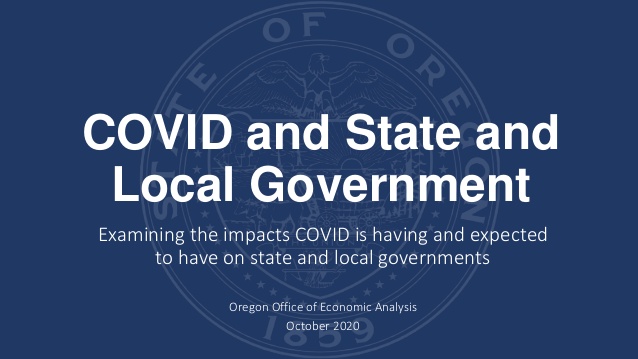
The COVID-19 pandemic has taken a toll in many economic sectors, and local government and education in Oregon are no exceptions.
In a new analysis, state economist Josh Lehner says, “The data it is quite clear that local government job losses are not a result of your standard budget cuts. That traditional recessionary dynamic is likely to come, but will hit next year, not this. The losses today are directly related to the pandemic and social distancing.”
Job losses in the local government sector were roughly equal as of September at around 6 percent from pre-pandemic employment levels. Nonfarm employment in the state plunged by almost 15 percent in April, while local government job loss peaked in May at around 9 percent. Since then, the nonfarm and local government sectors have regained jobs more or less in parallel until September when employment began to fall again in local government agencies.
Layoffs of schoolbus drivers and janitors and non-hiring of seasonal workers in school lunchrooms were expected when schools were shuttered, but the job losses Lehner sees also include teachers. Non-use of substitute teachers, he says, accounts for double-digit job losses in public schools. Nationally, substitute teachers make up 13 percent of total K-12 teaching jobs. The decline in teaching jobs hits women harder than men, Lehner says.
Higher education also hasn’t been immune from pandemic job losses. Enrollments are down by double digits, which means fewer regular and adjunct faculty members are being used. Remote learning also has led to job losses at dorms, student centers and recreation centers. Student workers have been trimmed, too.
The blow to educational employment follows a national trend. Librarians are down almost 34 percent, postsecondary instructors 29 percent, preschool and kindergarten teachers 20 percent, elementary and middle school teachers 17 percent and special education teachers 11 percent. Only high school teachers appear relatively unaffected with a 2.2 percent enrollment decline.
Layoffs of schoolbus drivers and janitors and non-hiring of seasonal workers in school lunchrooms were expected when schools were shuttered, but the job losses extend to teachers, especially substitute teachers, who make up 13 percent of the teacher workforce nationally.
COVID-related school closures have posed challenges for parents, whether they can work from home or not. Lehner estimates 40 percent of Oregon’s 2.1 million workers have children and as many as 350,000 children have parents who cannot work from home. Those children are disproportionately from households with Black or brown parents and lower incomes. Remote learning without parental supervision is complicated by a corresponding absence of high-speed internet connections.
Other parts of the public sector – zoos, convention centers, libraries and public pools – also have been closed or barely open, causing furloughs and layoffs.
The public sector, Lehner explains, is usually a stabilizing force at the beginning of economic recessions. That’s not the case now. US Bureau of Labor statistics indicate state and local governments shed 182,000 jobs as of September compared to a year ago.
While the latest state economist report released earlier this month shows state tax revenues booming, local governments face potential drops in lodging, sales and property tax revenues in the next year in the aftermath or continuation of the current economic recession.
The longer the coronavirus pandemic persists, the more precarious the economic prognosis.





